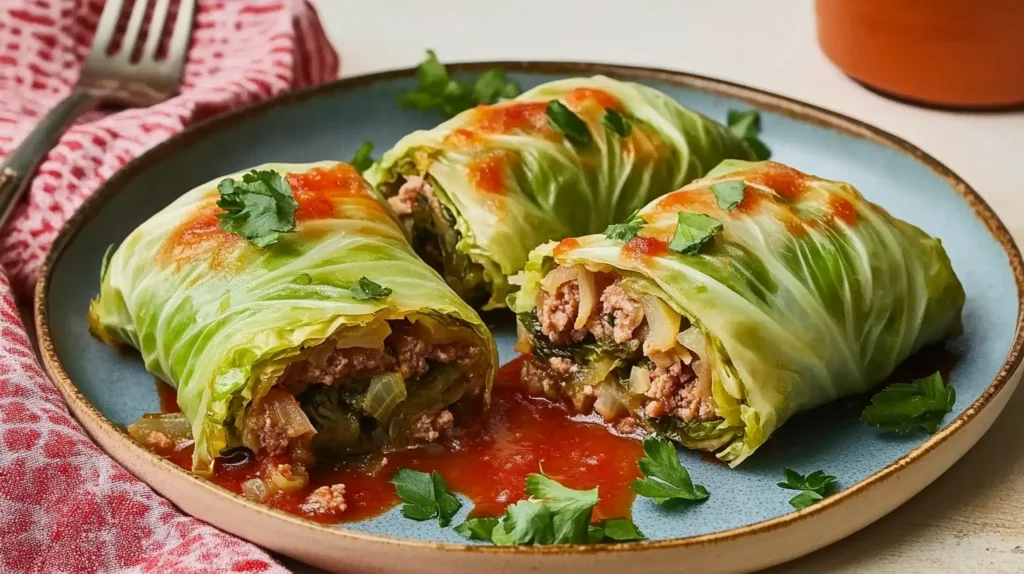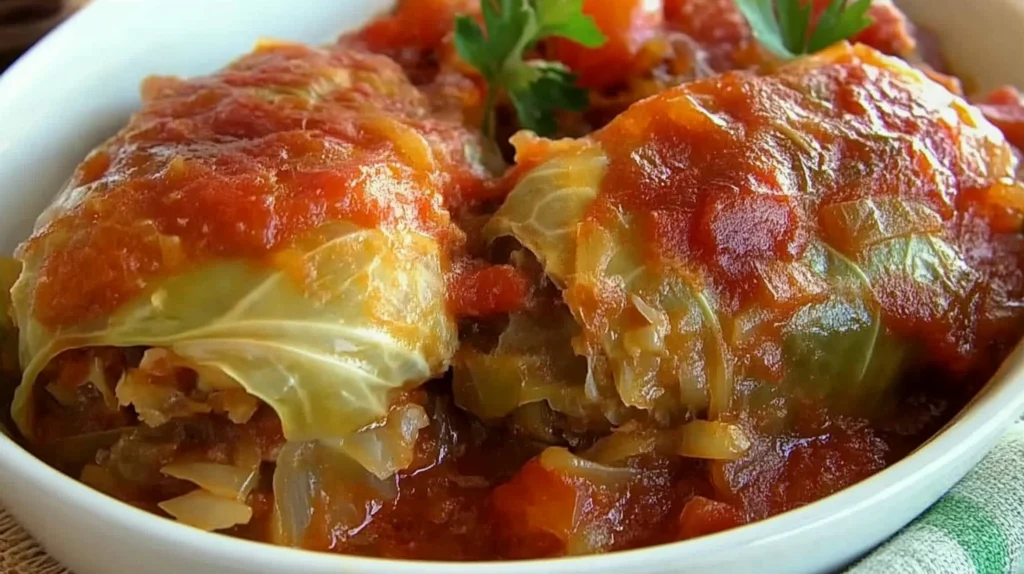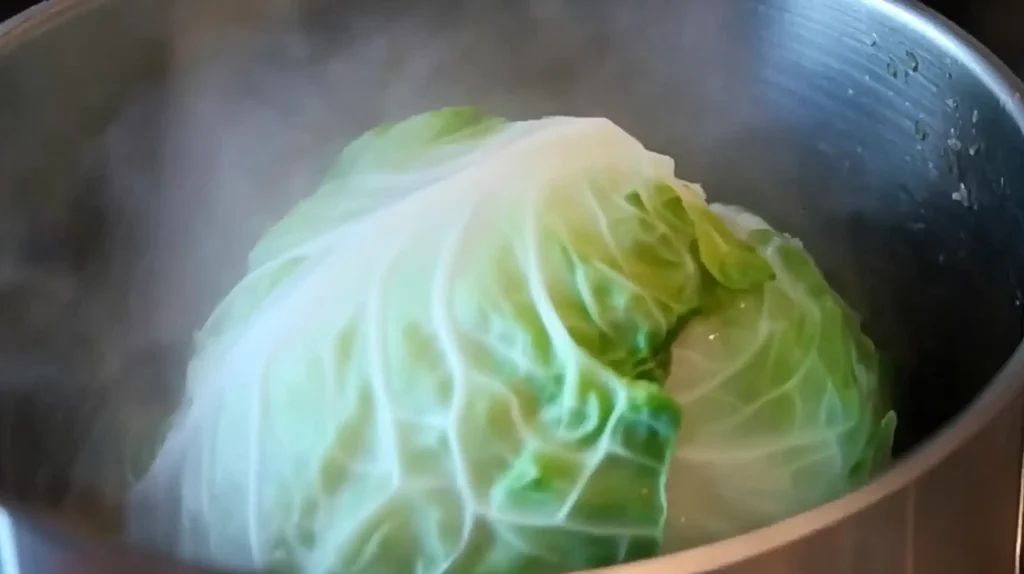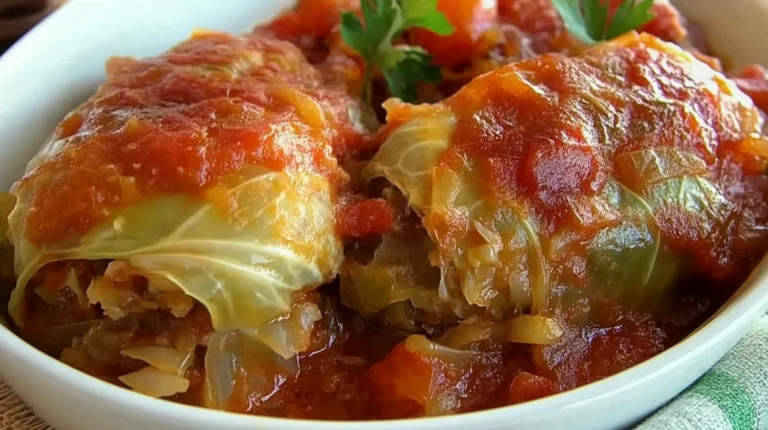
Understanding Stuffed Cabbage and its Texture
What is Stuffed Cabbage?
Stuffed cabbage, a dish rich in history and flavors, typically consists of cooked cabbage leaves wrapped around a savory filling. Originating from Eastern European cuisine, it’s known by various names across cultures like “golabki” in Poland, “holishkes” in Jewish communities, and “sarma” in several Balkan countries.
The filling usually comprises ground meat, such as beef or pork, combined with rice, spices, and sometimes vegetables. This blend of flavors and textures makes stuffed cabbage not just a meal but a comfort food for many.
I always thought my stuffed cabbage was tough because I wasn’t cooking it long enough. Turns out, the trick is in how you prep the cabbage leaves! Thanks for the tips, now it’s perfect every time! Emily, Home Cook
Growing up, I remember my grandmother making her special version of stuffed cabbage, slow-cooking it in a tangy tomato sauce. The aroma would waft through the house, wrapping us in a warm embrace, making it hard to resist sneaking a taste before dinner. This nostalgic dish represents love, culture, and family gatherings—values that we often hold close to our hearts.
Here’s a breakdown of what typical stuffed cabbage includes:
- Cabbage leaves: The outer layer that holds everything together.
- Filling: A hearty mix of proteins, grains, and seasonings.
- Sauce: Usually a tomato-based or rich broth to enhance flavor.
Importance of Texture in Stuffed Cabbage

Now, let’s talk about the texture of stuffed cabbage—this is where the magic truly happens. The texture plays a vital role in transforming this dish from ordinary to extraordinary. Imagine biting into a well-cooked stuffed cabbage, where the soft, tender leaves cradle a juicy, flavorful filling. It’s the perfect dance of textures that keeps your taste buds intrigued.
Here are some primary textures to consider when preparing stuffed cabbage:
- Cabbage: Ideally, the cabbage leaves should be tender yet firm enough to hold the filling without tearing. Overcooked cabbage can turn mushy, which detracts from the overall experience.
- Filling: A good filling strikes a balance between moist and firm. It should be well-seasoned and juicy, preventing dry bites that can ruin the enjoyment.
- Sauce: The sauce adds a rich, velvety texture that enhances both the cabbage and the filling. Too little sauce can leave the dish feeling dry, while too much may overwhelm the flavors.
Achieving the right texture in stuffed cabbage is crucial for a few reasons:
- Mouthfeel: A dish that offers a varied mouthfeel can elevate the entire dining experience. When textures complement each other—like the crunch of the cabbage versus the hearty filling—it makes every bite enjoyable.
- Flavor absorption: The right texture helps the filling absorb flavors from the sauce. A tender, porous filling melds beautifully with the sauce, creating a harmonious taste explosion.
- Presentation: Finally, texture plays an aesthetic role. Well-prepared stuffed cabbage looks appealing on the plate, with vibrant cabbage leaves and a luscious sauce coating.
To wrap it up, understanding the nuances of stuffed cabbage goes beyond just the ingredients. The right texture transforms this dish into a remarkable meal that resonates with our taste buds and memories. As I prepare my own families’ recipe, I find joy in perfecting each aspect, ensuring every bite is a harmonious blend of flavors and textures.
In the next sections, we will delve deeper into common pitfalls that lead to tough stuffed cabbage and provide tips on how to ensure your dish always comes out tender and delicious. Stay tuned!
Reasons for Tough Stuffed Cabbage
Continuing from our exploration of what makes stuffed cabbage a delightful culinary experience, it’s important to address some common mistakes that can lead to a less-than-ideal dish. There’s nothing worse than pulling out a tray of stuffed cabbage only to find that the leaves are tough and unyielding. Let’s dive into the main culprits of this predicament—overcooking and lack of sufficient moisture.
I made stuffed cabbage for the first time, and I couldn’t figure out why it turned out tough. After reading your article, I realized I wasn’t blanching the cabbage properly! Now it’s soft and flavorful. Jason, Beginner Chef
Overcooking

One major reason for tough stuffed cabbage is overcooking, which can occur with either the cabbage leaves themselves or the overall dish.
- Cabbage Leaves: If you boil or steam the leaves for too long before stuffing, they can lose their fresh, pliable nature and become rubbery. The ideal tender cabbage should be flexible enough to wrap without tearing but still maintain some structure.
- The Overall Dish: Stuffed cabbage requires a delicate balance in cooking time. While you want the filling to cook through thoroughly, you also don’t want to leave the dish in the oven or stovetop for too long. Overcooking can lead to dry, tough textures, which defeats the purpose of crafting a succulent meal.
I recall a time when I was preparing stuffed cabbage for a family gathering. Eager to impress, I decided to cook them a little longer to ensure the filling was fully done. To my dismay, I ended up with tough, chewy cabbage leaves that no amount of sauce could fix. It was a valuable lesson learned—timing is everything.
To avoid overcooking, here are some tips:
- Use a kitchen timer to keep track of cooking times.
- Check the texture of the cabbage leaves during the cooking process. They should be al dente.
- For the overall dish, monitor it closely as it cooks, testing for doneness about ten minutes before the suggested cooking time.
Lack of Sufficient Moisture
Another crucial factor is ensuring there is enough moisture present during the cooking process. Insufficient moisture can dry out both the cabbage and the filling, leading to an unappetizing meal.
- Steaming and Sauces: When cooking stuffed cabbage, especially in the oven, moisture from the sauce is vital. Baking them in a dry environment can result in tough and unappetizing textures. If the sauce evaporates, the cabbage leaves may turn leathery and the filling overly dry.
- Filling Moisture: The filling, composed mainly of meat and rice, can absorb a considerable amount of liquid during cooking. Be mindful to keep it moist when preparing the filling; adding ingredients like tomato sauce, broth, or even a hint of vinegar can significantly enhance both flavor and moisture.
During my attempts at perfecting my stuffed cabbage recipe, I learned the importance of covering the dish properly while cooking. There was one occasion where I forgot to add enough sauce, and by the time I checked, my beautiful wraps had dried out.
Here are some quick suggestions to ensure sufficient moisture:
- Always start with a flavorful sauce, and allow the stuffed cabbage to simmer in it.
- Cover your baking dish with foil for the majority of the cooking time to retain moisture.
- Add a bit of broth or water to the bottom of the dish if you’re concerned about it drying out too quickly.
As we continue on this culinary journey, keeping an eye on cooking times and moisture levels is essential for creating that tender, succulent stuffed cabbage we all love. In the next section, we’ll explore some tips for achieving the perfect texture every time, so don’t go away!
Tips for Tender Stuffed Cabbage
Now that we’ve tackled the reasons behind tough stuffed cabbage, let’s explore some practical tips for ensuring your culinary masterpiece turns out tender and delicious every time. With just a bit of attention to detail regarding cooking time and liquid, you’ll be well on your way to crafting the perfect dish that your family will rave about.
After reading the suggestions about using a slow cooker, my stuffed cabbage turned out incredibly tender! It’s the perfect dish for busy nights. Sarah, Busy Mom
Proper Cooking Time
Timing is a crucial factor when it comes to cooking stuffed cabbage. If you remember my previous cooking mishap, you’ll know that striking the right balance can prevent your dish from becoming tough or dry. Here’s how to nail your cooking time:
- Pre-Cook the Cabbage Leaves: Start by blanching or steaming the cabbage leaves until they are just tender. Typically, this takes about 3-5 minutes. The goal is to soften them enough to be pliable without losing their structure.
- Monitor the Cooking Process: If you’re cooking them in the oven, set a timer that allows you to check on your stuffed cabbage well before the suggested time. Depending on the recipe and size of your rolls, this could mean checking them about 30 minutes into a one-hour cooking time. You want to ensure the filling is cooked through while preventing the cabbage from becoming mushy.
- Use an Instant-Read Thermometer: If you’re ever unsure whether your filling is cooked, use an instant-read thermometer to check the internal temperature. For ground meat, this should read 160°F (71°C) to ensure it’s safe to eat.
As someone who once overcooked her stuffed cabbage during a family dinner, incorporating these timing tricks has really made a difference in achieving that tender perfection. I remember being anxious about serving dinner, but now I can confidently put together a delicious dish without the fear of rubbery leaves!
Adding Sufficient Liquid
One of the best secrets to achieving tender stuffed cabbage is ensuring there’s adequate moisture during the cooking process. Lack of moisture not only makes for chewy leaves but can also dry out your filling. Here’s how to ensure your stuffed cabbage is bursting with flavor and tenderness:
- Prepare a Flavorful Sauce: Start with a generous amount of sauce, whether it’s a rich tomato sauce, broth, or even a combination of both. Not only does this add moisture, but it infuses the cabbage and filling with flavor throughout the cooking process.
- Cover While Cooking: Whether you’re baking your stuffed cabbage or simmering it on the stovetop, cover the dish with a lid or aluminum foil. This traps steam, which helps cook the cabbage and filling evenly while preventing the surface from drying out.
- Add Liquid During Cooking: If you’re concerned that your dish might dry out, you can add additional broth or water to the bottom of your baking dish halfway through cooking. Just a cup can significantly boost moisture levels.
I once attended a potluck where my friend brought her amazing stuffed cabbage. When I asked her about her secret, she revealed that she always includes a hefty amount of sauce and covers her dishes tightly while baking. That’s a lesson I’ve taken to heart in my own kitchen!
To summarize, ensuring proper cooking time and adding sufficient liquid are key elements to achieving tender stuffed cabbage. With just a little attention, you can transform this traditional dish into a melt-in-your-mouth delight that your family will cherish.
In our next section, we’ll dive into adjusting cooking techniques. We’ll look at the benefits of steaming versus baking and how a pressure cooker can elevate your stuffed cabbage to new heights. Keep reading for even more insights!
Adjusting Cooking Techniques
As we continue our journey towards perfectly tender stuffed cabbage, it’s essential to consider how different cooking techniques can impact the final product. In this section, we’ll explore the merits of steaming versus baking, as well as the often-overlooked benefits of using a pressure cooker. Understanding these methods will not only enhance the texture of your dish but can also speed up your cooking process!
Steaming vs. Baking
Both steaming and baking have their unique advantages when it comes to cooking stuffed cabbage, and the choice between the two often depends on your personal preference and time constraints.
- Steaming: This method is fantastic for retaining moisture in your dish. When you steam stuffed cabbage, the leaves remain tender, and the filling is adequately cooked without the risk of drying out. Steaming allows the cabbage to absorb the flavors from the filling and any liquids you may use.
- How to Steam: You can use a bamboo steamer or a traditional steaming pot. Simply add water to your pot, bring it to a boil, and then place the stuffed cabbage in the steamer basket. Cover and steam for about 30-45 minutes, depending on the size of your rolls.
- Pro Tip: For added flavor, consider placing herbs or slices of lemon in the steaming water. This subtle infusion can elevate your dish.
- Baking: On the other hand, baking provides a wonderful caramelization effect, especially if you add a topping of cheese or breadcrumbs. Baking allows for a bubbly sauce to form around the cabbage, creating a delightful crust.
- How to Bake: Preheat your oven to 350°F (175°C). Place the stuffed cabbage in a baking dish, cover with sauce, and cover tightly with aluminum foil. Bake for about 1 hour, removing the foil for the last 15 minutes for a lovely golden finish.
- Personal Anecdote: One Thanksgiving, I decided to bake my stuffed cabbage for a twist on tradition. The guests couldn’t stop raving about the crispy top, and I realized how important the baking method can be to a dish’s overall impression.
Ultimately, both steaming and baking can yield delicious results. The method you choose can depend on the flavors you want to enhance or the texture you’re aiming for.
Using a Pressure Cooker
If you’re short on time but still crave that tender stuffed cabbage, a pressure cooker can be your best friend. This kitchen gadget works by using high-pressure steam to cook food, significantly reducing cooking time.
- Efficiency: The pressure cooker allows you to prepare stuffed cabbage in about half the time it would take using traditional methods. This is perfect for busy weeknights or when you have unexpected guests.
- How to Use: Begin by arranging your stuffed cabbage in the pressure cooker, oftentimes adding a bit of liquid to create steam. Secure the lid, and cook on high pressure for around 10-15 minutes. Once it’s done, let the pressure release naturally for the best results.
- Taste and Texture: Pressure cooking locks in moisture and flavor, leading to incredibly tender cabbage and juicy filling. I remember the first time I used a pressure cooker; the stuffed cabbage was done in a flash, yet it tasted like I had slaved away all day. It was an absolute game-changer for my busy lifestyle!
In summary, adapting your cooking technique can drastically improve the texture and flavor of your stuffed cabbage. Whether you choose to steam, bake, or use a pressure cooker, each method comes with its own set of advantages. The key is to find what works best for you and your lifestyle.
In the upcoming sections, we’ll discuss additional flavoring and tenderizing methods to take your stuffed cabbage to the next level. Stay tuned for even more tips and tricks!
Additional Flavoring and Tenderizing Methods
Now that we’ve covered the fundamental techniques for cooking tender stuffed cabbage, let’s delve into some additional methods for enhancing both flavor and texture. By incorporating acidic ingredients and boosting your dish with spices and herbs, you can take your stuffed cabbage from good to absolutely unforgettable.
Incorporating Acidic Ingredients
Adding acidic ingredients is a simple yet powerful way to tenderize your stuffed cabbage and elevate its flavors. The acidity breaks down proteins, making for a more tender filling while also brightening up the overall taste.
- Tomato Products: Most recipes already call for tomato sauce, but you can amp it up by using crushed tomatoes, diced tomatoes, or even a splash of tomato paste mixed into the sauce. The acidity of tomatoes enhances the flavor profile while tenderizing the filling.
- Vinegars: Consider adding a bit of vinegar to your sauce—balsamic, red wine, or apple cider vinegar can work wonders. A tablespoon or so mixed in can help to balance the richness of the meat while also providing that necessary zing.
- Citrus Juice: A little squeeze of lemon or lime at the end of cooking can brighten up the entire dish. Personally, I’ve found that adding lemon juice before serving offers a refreshing twist that brings all the flavors together beautifully.
- Personal Anecdote: I remember experimenting with a family recipe where I added a splash of red wine vinegar to the sauce during cooking. The result was a delightful balance of flavors and a more tender filling. My family still talks about that meal!
Here are some acidic options you can try:
| Acidic Ingredient | How to Use |
|---|---|
| Tomato sauce | Use as the base for your stuffed cabbage. |
| Balsamic vinegar | Add 1 tablespoon to the sauce. |
| Lemon juice | Squeeze in before serving. |
| White wine | Deglaze with a splash for added complexity. |
Enhancing Flavor with Spices and Herbs
Now that we’ve discussed acids, let’s explore how spices and herbs can transform the flavor of your stuffed cabbage. A well-seasoned filling can make a world of difference, creating a dish that’s bursting with character.
- Common Spices: Don’t shy away from spices! Paprika, cumin, and black pepper are excellent additions to give depth to your filling. A pinch of cayenne can also add a nice warmth, while smoked paprika brings in that rich, smoky flavor which is particularly lovely in a tomato-based sauce.
- Herbs: Fresh or dried herbs like parsley, dill, or thyme can enhance the filling significantly. For instance, adding fresh dill into your ground meat mix elevates the traditional stuffed cabbage flavor.
- Personal Touch: I’ve tried various herb blends in my cooking; I once added a bit of fresh parsley and basil to my filling, and the combination provided a lovely freshness that made the dish pop.
- Complementing Flavors: Remember to also consider how spices and herbs in the sauce can impact the overall dish. Bay leaves or a small bunch of thyme simmered in your sauce can add extra layers of flavor.
To help you further, here’s a summary of spices and herbs to experiment with:
| Flavor Enhancer | How to Use |
|---|---|
| Paprika (sweet or smoked) | Mix into meat filling for depth. |
| Black pepper | Season to taste in both filling and sauce. |
| Fresh dill | Stir into the meat before cooking. |
| Thyme | Add a sprig to the cooking sauce. |
In conclusion, incorporating acidic ingredients and enhancing your stuffed cabbage with spices and herbs can take your dish from ordinary to extraordinary. It’s these little touches that transform a classic recipe into something that resonates with your own unique flair.
As we wrap up our stuffed cabbage journey, I hope you feel inspired and equipped with a repertoire of techniques to create truly tender and flavorful stuffed cabbage. Happy cooking, and may your culinary adventures continue!g!
Print
Why is my stuffed cabbage tough?
Discover the secrets to making perfectly tender and flavorful stuffed cabbage. We cover common mistakes to avoid, the importance of texture, cooking techniques (steaming, baking, pressure cooking), and how to enhance flavors with acidic ingredients and spices. A complete guide to a comforting and foolproof dish!
- Total Time: 1 hour 50 minutes
- Yield: 4–6 servings 1x
Ingredients
- 1 large head of cabbage
- 1 lb (450g) ground beef (or a mix of beef & pork)
- 1 cup cooked rice
- 1 small onion, finely chopped
- 2 cloves garlic, minced
- 1 egg
- 1 tsp salt
- ½ tsp black pepper
- 1 tsp paprika
- ½ tsp dried thyme
- 2 cups tomato sauce
- 1 cup beef broth
- 2 tbsp vinegar (or lemon juice)
- 2 tbsp brown sugar (optional)
- 2 tbsp olive oil
Instructions
- Prep Cabbage: Boil cabbage for 3–5 minutes, peeling off leaves.
- Make Filling: Mix meat, rice, onion, garlic, egg, and spices.
- Roll: Place filling on each leaf, roll tightly, and tuck sides.
- Make Sauce: Simmer tomato sauce, broth, vinegar, and sugar for 5 minutes.
- Cook: Arrange rolls in a dish, pour sauce over, cover, and bake at 350°F (175°C) for 1.5 hours or simmer for 45–60 minutes.
- Serve: Let rest for 10 minutes and enjoy!
Notes
- For extra tenderness, refrigerate the rolls overnight before cooking.
- Try adding sauerkraut or diced tomatoes to the sauce for added depth.
- Works well with ground turkey or plant-based meat for a lighter version.
- Prep Time: 20 minutes
- Cook Time: 1 hour 30 minutes
- Category: Main Dish
- Method: Baking / Simmering
- Cuisine: European / Comfort Food
Nutrition
- Serving Size: 2 rolls
- Calories: 350 kcal
- Sugar: 6g
- Sodium: 600mg
- Fat: 18g
- Saturated Fat: 6g
- Unsaturated Fat: 10g
- Trans Fat: 0g
- Carbohydrates: 28g
- Fiber: 4g
- Protein: 22g
- Cholesterol: 70mg
